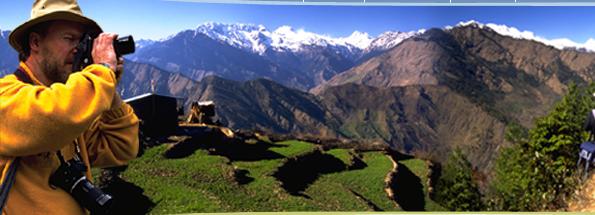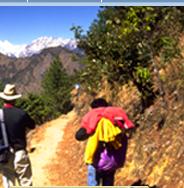Although
Nepal covers only a fraction of 1 per cent of
the earth’s land mass, it contains over
800 species of birds, about a tenth of the world’s
known birds, and of these more than half are found
within the national park. The reasons for Nepal’s
great wealth of birds are mainly topographical.
First, the country has a huge variation in altitude
within a short lateral distance, so that conditions
range from tropical to arctic in a distance of
less than 100 miles; and second, Nepal lies in
the region of the overlap between the Palaearctic
realm to the north and the Oriental to the south.
Chitwan, with its dense forests,
grasslands, rivers, swamps and lakes, provides
a multitude of habitats for birds. Each provides
a different type of food and shelter. Even within
the same habitat, different birds feed selectively,
minimizing competition for food. The Park is a
paradise for birds and birdwatchers alike.
Many birds are regarded as residents
because they live in the Park all year round;
others visit only in summer, often to breed. Another
group are the winter visitors which descend from
mountainous regions to spend the cold months in
a more hospitable climate. Migratory birds also
use the Park during spring and autumn when resting
on their journeys to northern breeding grounds
or southern wintering areas.
Possibly the most spectacular of
all Chitwan’s birds is the common peacock.
His brilliant plumage and magnificent tail, particularly
when it is erected into a great circular fan during
courtship displays, are an impressive sight. In
spite of his long, trailing tail, the peacock
often flies into tall trees, announcing his presence
with a loud, trumpeting call. Groups of the comparatively
drab, gray-brown females are often disturbed in
grassy areas near forest edges as they search
for insects, small snakes and geckos, fruits or
green shoots.
Its seems remarkable that well over
half of the birds listed for Nepal should be found
here, the reason is that the park’s heterogeneous
environment provides a multitude of ecological
niches for birds to exploit. For instance, the
river systems and associated bodies of water contain
a wide assortment of aquatic fauna and flora,
while the forest and grasslands provide flowers,
nectar, fruits and seeds, as well as the ubiquitous
insects.
Chitwan supports a poor population
of fishing raptors. All the same, ospreys, cormorants,
darters, fishing eagles, mergansers, fish owls
and white-tailed sea eagles hunt medium-to-large
fish, and gulls, terns and kingfishers take smaller
ones. Besides fish, the rivers, marshes and lakes
support a wide array of crustaceans, mollusks,
frogs, tadpoles, worms, aquatic insects and so
on, which are preyed upon by herons and storks
(both also take fish), bitterns, waders and crakes.
Moorhens, cranes, ducks and geese feed on the
same things, but are also vegetarians to a greater
or lesser extent, eating roots, tubers and seeds
of aquatic plants. The greylag and barheaded geese,
teals, pintails, spotbills and garganey are largely
plant-feeders and partial to cultivated fields,
as are the common and demoiselle cranes. On the
other hand, the hand goldeneye and the tufted
duck are believed to be more depended on animal
food.
Birds of prey (including owls) hunt
small mammals, birds, eggs and nestling, besides
reptiles and insects. Vultures maintain sanitation
in nature by scavenging. Green pigeons are fruit-eaters,
and their smaller relatives, the doves, are grain
and seed-eaters. Parakeets, which are a bit of
both, do much damage to crops and orchards. Sparrows,
munias, buntings and weavers feed on grass seeds,
and sunbirds live on the nectar of flowers.
Hornbills, barbets, orioles, mynas
and bulbuls subsist mainly on fruit, but supplement
their diet with insects. The reverse may be true
for many of the remaining birds. Insects are hawked
in the air by bee-eaters, swifts, swallows, martins
and drongos; woodpeckers and nuthatches search
for them on tree trunks, and wall creepers on
vertical cliffs.
Pittas scan through leaf litter, forktails hunt
forest streams, and wagtails prey upon insects
along the stream and river beds. Bush chats, babblers,
shrikes and prinias control insects in the grasslands,
together with the rare rubythroat and the bluethroat,
prefer to stay on the ground. Others such as minivets
and allies, flycatchers, leaf warblers and cuckoos
hunt insects in the forest canopies.
Red-billed blue magpies may be seen
at the tiger kills early in the mornings, and
the dark kite and the house sparrow live alongside
man. Elsewhere flowerpeckers are closely associated
with mistletoe fruit. Jungle mynas ride on rhinos,
and often flocks of them betray the presence of
the pachyderms in tall grass. The mynas benefit
by feeding on insects that fly off the vegetation
as the clumsy giants crash through it. Similarly,
egrets and pied mynas accompany grazing herds
of cows and buffalo. While some birds are highly-specialized
feeders, others tend to be omnivorous in varying
degrees.
At the apex of the avian food chain
are the birds of prey, and apart from the vultures,
which congregate in large numbers at a carcass,
they are usually seen singly or in pairs. The
ways in which evolution has adapted these birds
of prey for a life of hunting or scavenging can
be seen in the make up of their wings, tails,
feet, beaks and eves.
In over a hundred species of birds
that are seen in Chitwan, the males differ from
the females in appearance. Yet the differences,
although pronounced in some, are only minor in
others. As a general rule, males are more brilliantly
colored and therefore more attractive: minivets,
peafowl, junglefowl, parakeets, sunbirds, woodpeckers,
green pigeons, most ducks and flycatchers - are
all good examples. In the great majority of our
birds, however, both sexes look alike.
Courtship display - an integral
part of pair-formation - varies as widely as do
the species themselves. From January to May the
spectacular dance of the peacock is a common sight
in Chitwan: the male raises his tail- feathers
vertically into a huge fan, with the iridescent
moons facing forward, and pivots back and forth
in a graceful pavane. Scarcely less impressive
are the displays of the egrets during the monsoon.
These slender, longlegged white herons raise and
lower their feathers, forming white sprays round
their crests and bodies, and thereby making themselves
still more striking. Another of the great sights
of spring is the flight display of the crested
serpent eagle. Twisting and turning and rolling
in the air, each pair performs thrilling aerobatics.
By late April most of our winter
birds have gone, while others have arrived for
nesting. As the breeding season begins, songsters
fill the air with lovely melodies, and after dark
the nightjars, owls and cuckoos sing all night
long. In short, the males are competing with other
males for mates, but that is not the whole story.
The female painted snipe and common bustard-quail
are larger and slightly brighter-colored than
the male.
Most of our wintering ducks and
waders are Trans-himalayan migrants, their breeding
grounds extending as far north as Siberia and
the Arctic circle. Some annual migrants travel
vast distances. Yet many birds are merely regional
migrants, and do not travel long distances. The
paradise flycatchers and the black-naped monarch
flycatcher arrive for breeding in summer from
within the Indian subcontinent. Wintering leafwarblers
and flycatchers such as orange-gorgetted, rufous-
breasted, rusty-breasted, little pied and slaty
blue, are said to breed higher up in the Himalayas,
and are therefore latitudinal migrants. Still
other birds use Chitwan only for a brief stopover
on their way to or from their breeding grounds.
These include the demoiselle crane, sooty flycatcher,
curlew and spot winged stare.
|




